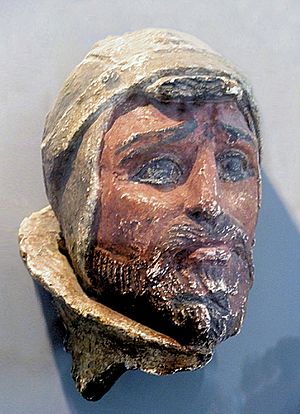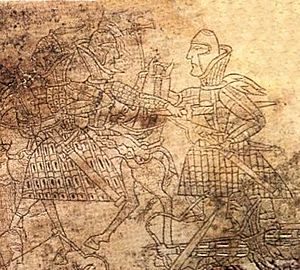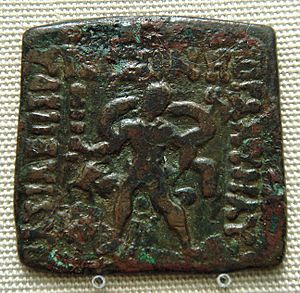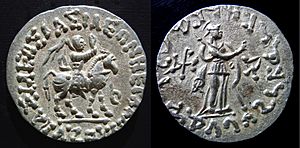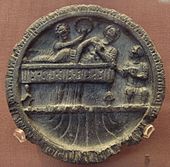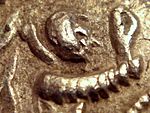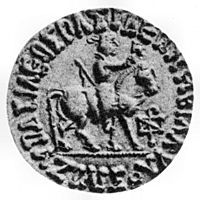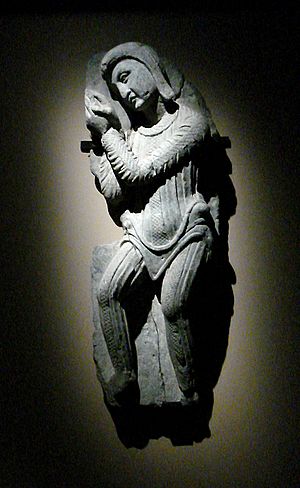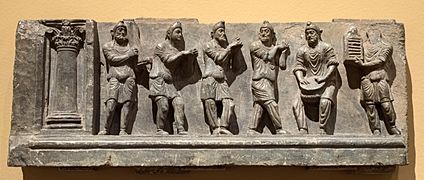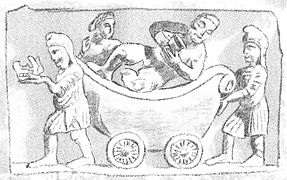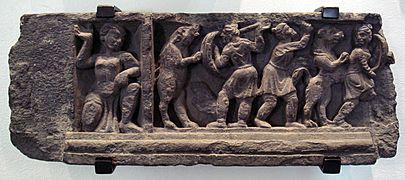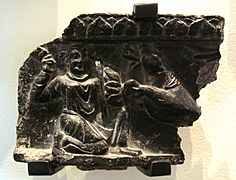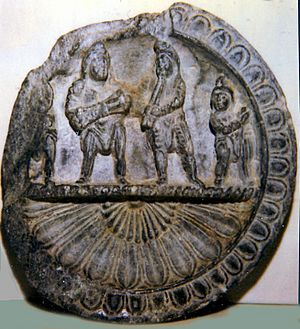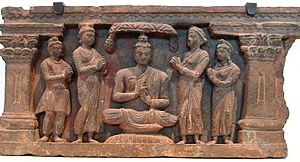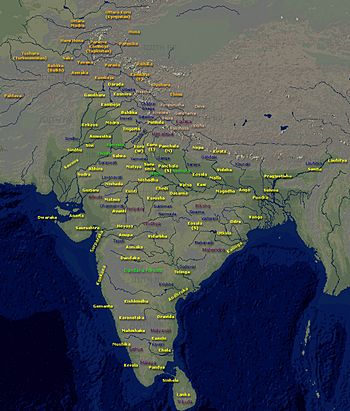Indo-Scythians facts for kids
Quick facts for kids
Indo-Scythian Kingdom
|
|||||||||||||||||||||
|---|---|---|---|---|---|---|---|---|---|---|---|---|---|---|---|---|---|---|---|---|---|
| c. 150 BC–400 AD | |||||||||||||||||||||
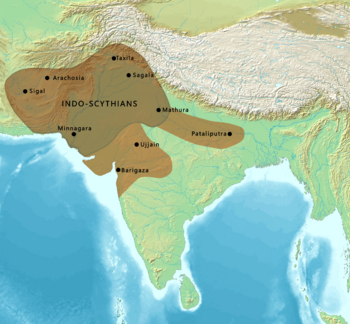
Territories and expansion of the Indo-Scythians at their greatest extent, including territories of the Northern Satraps and Western Satraps.
|
|||||||||||||||||||||
| Capital | |||||||||||||||||||||
| Common languages | Saka, Greek, Pali (Kharoshthi script), Sanskrit, Prakrit (Brahmi script) |
||||||||||||||||||||
| Religion | |||||||||||||||||||||
| Government | Monarchy | ||||||||||||||||||||
| King | |||||||||||||||||||||
|
• 85–60 BC
|
Maues | ||||||||||||||||||||
|
• 10 AD
|
Hajatria | ||||||||||||||||||||
| Historical era | Antiquity | ||||||||||||||||||||
|
• Established
|
c. 150 BC | ||||||||||||||||||||
|
• Disestablished
|
400 AD | ||||||||||||||||||||
| Area | |||||||||||||||||||||
| 20 est. | 2,600,000 km2 (1,000,000 sq mi) | ||||||||||||||||||||
|
|||||||||||||||||||||
The Indo-Scythians (also called Indo-Sakas) were a group of nomadic people. They were part of the Scythians, who were an Iranian group. They moved from Central Asia south into parts of modern-day Afghanistan, Pakistan, and northern India. These migrations happened between the mid-2nd century BCE and the 4th century CE.
The first Saka king in India was Maues (in the 1st century BCE). He set up Saka power in areas like Gandhara and the Indus Valley. The Indo-Scythians took control over northwestern India. They conquered the Indo-Greeks and other local kingdoms. Later, the Kushan Empire likely took over the Indo-Scythians. This happened under leaders like Kujula Kadphises or Kanishka.
However, the Saka people continued to rule as local governors called satrapies. These were known as the Northern Satraps and Western Satraps. The power of the Saka rulers began to fade in the 2nd century CE. This was after the Indo-Scythians were defeated by the Satavahana emperor Gautamiputra Satakarni. Indo-Scythian rule in northwestern India ended when the last Western Satrap Rudrasimha III was defeated. This happened in 395 CE by the Gupta Empire emperor Chandragupta II.
The arrival of Scythian tribes from Central Asia in northern India was a big event. It greatly impacted the history of the subcontinent. This movement was part of a larger chain of events. Nomadic groups in Central Asia were fleeing conflicts with tribes like the Xiongnu. These events affected Bactria, Kabul, and India. They also had effects as far away as Rome in the west.
Ancient Roman historians like Arrian and Claudius Ptolemy wrote about the ancient Sakas ("Sakai"). They described them as nomadic people.
The first rulers of the Indo-Scythian Kingdom were Maues (around 85–60 BCE) and Vonones (around 75–65 BCE).
Contents
- Who Were the Indo-Scythians?
- Where Did the Indo-Scythians Settle?
- Indo-Scythian Kingdoms and Their Expansion
- Indo-Scythian Coins
- Indo-Scythian Art
- Indo-Scythians and Buddhism
- Indo-Scythians in Indian Writings
- Indo-Scythians in Roman Sources
- Main Indo-Scythian Tribes and Rulers
- Descendants of the Indo-Scythians
- See Also
Who Were the Indo-Scythians?

The Indo-Scythians are believed to be descendants of Sakas (Scythian) tribes. These tribes were part of a larger group of nomads. They lived across Siberia and the Central Eurasian steppes. Like the Scythians described by Herodotus, the Sakas were Iranian-speaking horse nomads. They used chariots in battle and buried their dead in mound tombs called kurgans.
The Sakas in Western India spoke the Saka language. This language is also known as Khotanese.
Early Connections: Achaemenids and Others
During the Achaemenid conquest of the Indus Valley around 515 BCE, Sakas likely joined the army. The Achaemenid army included many different groups. These groups were part of the large Achaemenid Empire. They included Bactrians, Sakas, Parthians, and Sogdians. These groups probably took part in the invasion of northwestern India.
Some experts think the Shakyas, the family of Gautama Buddha, were originally Scythians. The Indian name Śākya might come from the same root as "Scythian." This could explain why the Sakas strongly supported Buddhism in India.
Persians, Sakas, and Greeks might have helped Chandragupta Maurya. He wanted to take the throne of Magadha around 320 BCE. An ancient text, the Mudrarakshasa, says an alliance of "Shaka-Yavana-Kamboja-Parasika-Bahlika" helped Chandragupta. He used them to create the Mauryan Empire.
Nomadic Movements and the Yuezhi Tribe
In the 2nd century BCE, new nomadic movements began in Central Asia. These movements had big effects on many regions. They impacted Rome, Parthia, Bactria, Kabul, and India. Chinese records from the Han dynasty describe these tribal movements. They started after the Yuezhi tribe was defeated by the Xiongnu. The Yuezhi fled west, causing other tribes to move. This was like a domino effect.
Around 175 BCE, the Xiongnu tribe attacked the Yuezhi. This forced the Yuezhi to leave their homeland. They moved west into the Ili River area. There, they pushed out the Sakas. The Sakas then moved south into Ferghana and Sogdiana. Chinese records say: "[The Yuezhi] attacked the king of the Sai (Sakas), who moved a long way south."
After 155 BCE, the Yuezhi were defeated again. This time, it was by an alliance of the Wusun and the Xiongnu. They had to move south again. This forced the Scythians to migrate south towards Bactria and present-day Afghanistan. They also moved southwest towards Parthia.
The Sakas entered the Greco-Bactrian Kingdom around 145 BCE. They burned the Greek city of Alexandria on the Oxus. The Yuezhi stayed in Sogdiana. But they became the main power over the Sakas in Bactria. This was noted by the Chinese ambassador Zhang Qian around 126 BCE.
In Parthia, between 138–124 BCE, a tribe called the Sacaraucae fought the Parthian Empire. They were allied with the Massagetae. This alliance won battles and killed two Parthian kings.
The Parthian king Mithridates II eventually regained control. He defeated the Yuezhi in Sogdia in 115 BCE. Then he defeated the Scythians in Parthia and Seistan around 100 BCE.
After their defeat, the Yuezhi tribes moved east into Bactria. They controlled this area for centuries. From there, they later conquered northern India and founded the Kushan Empire.
Where Did the Indo-Scythians Settle?

The Sakas settled in Drangiana. This area is in southern Afghanistan, western Pakistan, and southern Iran. It was later named Sakastan or Sistan after them. From there, they slowly expanded into Iran and northern India. In India, they set up various kingdoms and were known as "Saka."
These mixed Scythian groups moved into Drangiana and nearby regions. They then spread into northern and southwestern India. They went through the lower Indus valley. Their migration reached Sovira, Gujarat, Rajasthan, and other parts of northern India.
The Arsacid emperor Mithridates II (around 123–88/87 BCE) was very active militarily. He added many provinces to the Parthian Empire. This included Western Bactria, which he took from the Indo-Scythians.
Due to pressure from the Yuezhi (who later became the Kushans), some Indo-Scythians moved. They went from Bactria to Lake Helmond (or Hāmūn). They settled in or near Drangiana (Sigal). This region later became known as "Sakistana." It is still called Seistan today.
The presence of Sakas in Sakastan in the 1st century BCE is mentioned by Isidore of Charax. He wrote about it in his "Parthian stations." He said they were bordered by Greek cities to the east. To the south was the Parthian-controlled area of Arachosia.
Indo-Scythian Kingdoms and Their Expansion
From Pamirs to Taxila
Experts like Ahmad Hassan Dani and Karl Jettmar studied rock carvings. These carvings were left by Saka soldiers at river crossings in Pakistan. They show the route Maues, the first Indo-Scythian king, used. He crossed the Karakoram mountains to capture Taxila from the Indo-Greek King Apollodotus II.
The 1st century CE Periplus of the Erythraean Sea describes Scythian lands. It mentions the coast of Scythia, which is marshy. The Indus River flows through it into the Erythraean Sea. The river has seven mouths, but only one is navigable. Near it is the market-town of Barbarikon. Inland is Minnagara, the capital of Scythia. Parthian princes often fought for control of this city.
The Indo-Scythians eventually set up a kingdom in the northwest. Its main center was near Taxila. They also had two important governors (Satraps). One was in Mathura in the east. The other was in Surastrene (Gujarat) in the southwest.
In the southeast, the Indo-Scythians invaded Ujjain. But they were pushed back in 57 BCE by the Malwa king Vikramaditya. To remember this victory, Vikramaditya started the Vikrama era. This is an Indian calendar beginning in 57 BCE. More than a century later, in 78 CE, the Sakas invaded Ujjain again. They established the Saka era, marking the start of the Western Satraps kingdom.
Gandhara and Punjab
The Scythians were present in modern-day Pakistan and northwestern India in the 1st century BCE. They lived at the same time as the Indo-Greek Kingdoms. It seems they first accepted the power of the local Greek rulers.
Maues first conquered Gandhara and Taxila around 80 BCE. But his kingdom broke apart after his death. In the east, the Indian king Vikrama took back Ujjain from the Indo-Scythians. He celebrated by creating the Vikrama era (starting 58 BCE). Indo-Greek kings ruled again after Maues. They did well, as shown by many coins from Kings Apollodotus II and Hippostratos. The Indo-Scythians finally took control of northwestern India with Azes I in 55 BCE. They defeated Hippostratos.
Indo-Scythian Sculpture
Archaeological digs led by John Marshall found several stone sculptures. These were in the Early Saka layer (Layer No4). Many coins of Azes I were also found there.

Some of these sculptures are toilet trays (also called stone palettes). They tried to copy older, more detailed Greek examples. Marshall noted that they were "a praiseworthy effort to copy a Hellenistic original." From the same layer, some statues were found. They were very stiff and faced forward.
The Bimaran Casket
Azes is linked to the Bimaran casket. This is one of the earliest images of the Buddha. The casket was used to dedicate a stupa in Bamiran, near Jalalabad in Afghanistan. It was placed inside the stupa with several coins of Azes. This might have happened during Azes' rule (60–20 BCE) or a bit later. The Indo-Scythians were connected with Buddhism. So, it's possible they ordered this artwork.
Mathura Area: The Northern Satraps
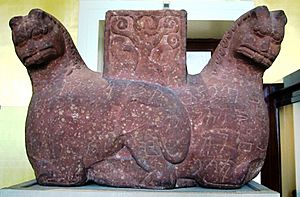
In northern India, the Indo-Scythians took over the Mathura area. This happened around 60 BCE, from Indian kings. Some of their governors (satraps) were Hagamasha and Hagana. They were followed by the great Saka Satrap Rajuvula.
The Mathura lion capital is an Indo-Scythian stone carving. It's from Mathura and dates to the 1st century CE. It describes a gift of a stupa with a Buddha relic. This gift was made by Queen Nadasi Kasa, wife of the Indo-Scythian ruler Rajuvula. The capital also lists the family tree of several Indo-Scythian satraps of Mathura.
Rajuvula likely defeated the last Indo-Greek king Strato II around 10 CE. He took his capital city, Sagala.
Coins from this time, like those of Rajuvula, became very simple in style. They also used less silver and more bronze. This suggests they had less wealth.
The Mathura lion capital inscriptions confirm that Mathura came under Saka control. The inscriptions mention Kharahostes and Queen Ayasia. She was the "chief queen of the Indo-Scythian ruler of Mathura, satrap Rajuvula." Kharahostes was the son of Arta, who was the brother of King Moga or Maues.
The Indo-Scythian satraps of Mathura are sometimes called the "Northern Satraps." This is to tell them apart from the "Western Satraps" who ruled in Gujarat and Malwa. After Rajuvula, several rulers were vassals (local rulers under a larger power) to the Kushans. These included "Great Satrap" Kharapallana and "Satrap" Vanaspara. An inscription from Sarnath (around 130 CE) shows they were loyal to the Kushans.
Pataliputra and Later Conquests
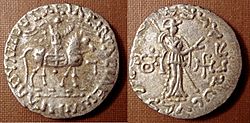
The Yuga Purana describes an invasion of Pataliputra by Scythians. This happened sometime in the 1st century BCE. The text says the Saka king killed many people. But he was then killed by the Kalinga king Shata.
After Azes died, Indo-Scythian rule in northwestern India weakened. This was due to the rise of the Indo-Parthian ruler Gondophares in the late 1st century BCE. For decades, smaller Scythian leaders held onto local strongholds. Some of them formally accepted Gondophares I and his successors as their overlords.
In the later 1st century CE, the Kushan Empire gradually took over from the Indo-Parthians. The Kushans were one of the five tribes of the Yuezhi. They had lived in Bactria for over a century. Now, they were expanding into India. The Kushans eventually took back northwestern India around 75 CE. They also took the Mathura area around 100 CE. They would rule these areas for several centuries.
The Western Kshatrapas

Indo-Scythians continued to control Seistan until the reign of Bahram II (276–293 CE). They also held parts of India well into the 1st millennium. Kathiawar and Gujarat were under their rule until the 5th century. They were known as the Western Kshatrapas. The Kshatrap Rudradaman I was a famous conqueror. His achievements are written in the Junagadh rock inscription of Rudradaman. He conquered the Yaudheyas and defeated the Satavahana Empire. The Western Kshatraps were finally conquered by the Gupta Empire emperor Chandragupta II.
Indo-Scythian Coins
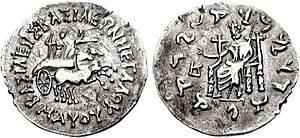
Indo-Scythian coins are generally well-made. However, their quality declined as Indo-Scythian rule ended around 20 CE (coins of Rajuvula). A good quality, but simple, coinage continued in the Western Satraps until the 4th century.
Indo-Scythian coins are quite realistic. Their artistic style is between Indo-Greek and Kushan coins. It's often thought that Greek artists helped make Indo-Scythian coins.
Indo-Scythian coins followed the Indo-Greek style. They used the Greek language on one side and the Kharoshthi language on the other. However, the king's portrait is never shown. Instead, they show the king on a horse (or sometimes a camel). Sometimes, he is sitting cross-legged on a cushion. The other side of their coins usually shows Greek gods.
Buddhist symbols are often seen on Indo-Scythian coins. For example, they continued the Indo-Greek practice of showing gods making the vitarka mudra (a hand gesture). This is seen with Zeus on coins of Maues or Azes II. Also, the Buddhist lion appears on coins of these two kings. The triratana symbol is on coins of Zeionises.
Indo-Scythian Art
Besides coins, not many artworks clearly show Indo-Scythians. Indo-Scythian rulers are usually shown on horseback in armor. But the coins of Azilises show the king in a simple tunic.
Some Gandharan sculptures show foreigners in soft tunics. They sometimes wear the pointed hat typical of Scythians. This is different from Kushan men. Kushans seem to wear thick, stiff tunics. They are also usually shown in a simpler way.
Buner Reliefs
Indo-Scythian soldiers in military clothes are sometimes shown in Buddhist art from Gandhara. This is especially true in the Buner reliefs. They are shown in loose tunics with trousers. They carry heavy, straight swords. They wear pointed hoods or the Scythian cap. This helps tell them apart from Indo-Parthians. Indo-Parthians wore simple headbands and had bushy hair. Indo-Scythian rulers on their coins always wear this cap. With their right hand, some soldiers make the Karana mudra against evil spirits. In Gandhara, these carvings decorated the bases of Buddhist stupas. They were made at the same time as other carvings showing people in Greek clothes. This suggests that Indo-Scythians (who had military power) and Indo-Greeks (who lived civilian lives under Indo-Scythian rule) mixed.
Another carving shows the same type of soldiers playing music and dancing. These activities are common in Gandharan art. Indo-Scythians are often shown as joyful followers.
-
One of the Buner reliefs showing Scythian soldiers dancing. Cleveland Museum of Art.
Stone Palettes
Many stone palettes found in Gandhara are good examples of Indo-Scythian art. These palettes mix Greek and Iranian styles. They are often made in a simple, old-fashioned way. Stone palettes have only been found in archaeological layers from Indo-Greek, Indo-Scythian, and Indo-Parthian rule. They are not found in earlier Mauryan or later Kushan layers.
These palettes often show people in Greek clothes in mythological scenes. A few show people in Parthian clothes (head-bands, crossed jackets, jewelry, baggy trousers). Even fewer show people in Indo-Scythian clothes (Phrygian hat, tunic, and straight trousers). A palette from Sirkap shows a winged Indo-Scythian horseman riding winged deer. A lion is attacking him.
Indo-Scythians and Buddhism
The Indo-Scythians seem to have followed Buddhism. Many of their practices continued those of the Indo-Greeks.
Royal Support for Buddhism
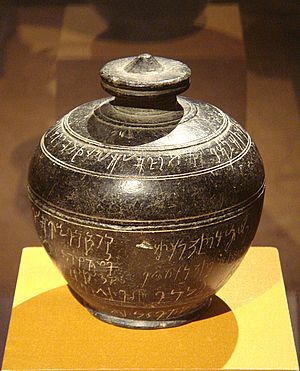
Several Indo-Scythian kings after Azes made Buddhist dedications. These were on plaques or reliquaries (containers for relics):
- Patika Kusulaka (25 BCE – 10 CE) donated a relic of the Buddha Shakyamuni to a Buddhist monastery. This is recorded in the Taxila copper plate.
- Kharahostes (10 BCE – 10 CE) is mentioned on the Buddhist Mathura lion capital and on a reliquary. His coins were also found in the Bimaran casket. This is a beautiful Buddhist gold reliquary with an early image of the Buddha. Some of his coins have the Buddhist triratna symbol.
- Vijayamitra (ruled 12 BCE - 15 CE) personally dedicated a Buddhist reliquary. Some of his coins have the Buddhist triratna symbol.
- Indravarman, while still a Prince, dedicated a Buddhist reliquary in 5-6 CE. This was the Bajaur casket.
- Zeionises and Aspavarma also used the Buddhist triratna symbol on their coins.
- Rajuvula set up the Mathura lion capital. It includes Buddhist symbols and mentions his wife's donations of relics to a stupa.
Butkara Stupa
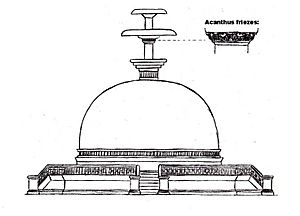
Excavations at the Butkara Stupa in Swat found Buddhist sculptures. These are believed to be from the Indo-Scythian period. An Indo-Corinthian capital (a type of column top) was found. It showed a Buddhist follower within leaves. A reliquary and coins of Azes were buried at its base. This dates the sculpture to around 20 BCE. A similar pillar with a Buddhist follower in Greek dress was also found. This again suggests that the two groups mixed. Various carvings at the same site show Indo-Scythians in their typical tunics and pointed hoods. They are seen in a Buddhist setting, next to carvings of standing Buddhas.
Gandharan Sculptures
Other carvings show Indo-Scythian men with their pointed caps. They are pushing a cart with the Greek god Dionysos and his partner Ariadne.
Mathura Lion Capital
The Mathura lion capital links many Indo-Scythian rulers from Maues to Rajuvula. It mentions a dedication of a Buddha relic in a stupa. It also has the Buddhist symbol of the triratana in the center. It is full of mentions of the Buddha Sakyamuni and Buddhist phrases like:
- "sarvabudhana puya dhamasa puya saghasa puya"
- "Revere all the Buddhas, revere the dharma (teachings), revere the sangha (community)"
- (Mathura lion capital, inscription O1/O2)
Indo-Scythians in Indian Writings
The Indo-Scythians were called "Shaka" in India. This name came from "Saka," which Persians used for Scythians. Shakas are mentioned many times in texts like the Purāṇas, the Manusmṛti, the Rāmāyaṇa, and the Mahābhārata. They are described as part of a group of warlike tribes from the northwest.
There are important mentions of the warring Mleccha (foreign) groups of Sakas, Yavanas, Kambojas, and Pahlavas. These are in the Balakanda of the Valmiki Ramayana. Some historians see these verses as describing the fights between Hindus and invading foreign groups from the northwest. These struggles happened from the 2nd century BCE onwards.
The Mahabharata also hints at the invasion of mixed groups from the northwest. The Vanaparava section of the Mahabharata has prophecies. It says that "the Mlechha (barbaric) kings of the Shakas, Yavanas, Kambojas, Bahlikas, etc., shall rule the earth unfairly in Kali Yuga..."
Like many old epics, the Ramayana and Mahabharata have been changed over time. This makes it hard to date them exactly. It is very likely that these additions were made as political situations changed and new people joined society.
Indo-Scythians in Roman Sources

The region of Scythia, in modern-day Pakistan, is mentioned in Western maps. It is especially noted around the mouth of the Indus River. Its capital was Minnagara (modern-day Karachi). The Ptolemy world map and Periplus of the Erythraean Sea clearly show Scythia in the Indus Valley. The Roman Tabula Peutingeriana also shows it. The Periplus says that Minnagara was the capital of Scythia. It also notes that Parthian princes were fighting for control there in the 1st century CE. It also separates Scythia from Ariaca further east. Ariaca was centered in Gujarat and Malwa. The Western Satrap king Nahapana ruled there.
Main Indo-Scythian Tribes and Rulers
Khyber-Pakhtunkhwa, Eastern Afghanistan, Eastern Pakistan, and Kashmir
- Maues, c. 85–60 BCE
- Vonones, c. 75–65 BCE
- Spalahores, c. 75–65 BCE, a governor and brother of King Vonones.
- Spalagadames, c. 60–57 BCE, a governor and son of Spalahores.
- Spalirises c. 50 BCE, king and brother of King Vonones.
- Azes I was also from the family of Maues, c. 48/47 – 25 BCE
- Azilises, c. 60–20 BCE
- Zeionises, c. 10 BCE – CE 10
- Kharahostes, c. 10 BCE – CE 10
- Hajatria
Kshaharatas (Punjab, Pakistan and beyond)
- Liaka Kusuluka, governor of Chuksa
- Kusulaka Patika, governor of Chuksa and son of Liaka Kusuluka
- Bhumaka
- Nahapana (who started the Western Satraps)
Aprācas (Bajaur, Khyber-Pakhtunkhwa, Afghanistan, Pakistan)
- Vijayamitra (12 BCE - CE 15), his wife was Rukhana
- Indravasu (c. CE 20), his wife was Vasumitra
- Vispavarman, his wife was Śiśirena
- Indravarman, his wife was Uttara
- Aspa (CE 15–45) or Aspavarma (CE 15 - 45)
- Sasan
Pāratas (Balochistan, Pakistan)
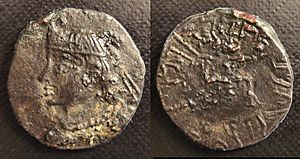
Obv: Robed bust of Bhimarjuna.
Rev: Swastika with writing around it.
- Yolamira, son of Bagareva (c. 125–150)
- Bagamira, son of Yolamira (c. 150)
- Arjuna, a second son of Yolamira (c. 150–160)
- Hvaramira, a third son of Yolamira (c. 160–175)
- Mirahvara, son of Hvaramira (c. 175–185)
- Miratakhma, another son of Hvaramira (c. 185–200)
- Kozana, son of Bagavharna (c. 200–220)
- Bhimarjuna, son of Yolatakhma (c. 220–235)
- Koziya, son of Kozana (c. 235–265)
- Datarvharna, son of Datayola I (c. 265–280)
- Datayola II, son of Datarvharna (c. 280–300)
"Northern Satraps" (Mathura area)
- Hagamasha (governor, 1st century BCE)
- Hagana (governor, 1st century BCE)
- Rajuvula, c. CE 10 (Great Governor)
- Sodasa, son of Rajuvula
- "Great Satrap" Kharapallana (c. CE 130)
- "Satrap" Vanaspara (c. CE 130)
Minor Local Rulers
- Bhadayasa
- Mamvadi
- Arsakes (Indo-Scythian)
Western Satraps
- Nahapana (119–124)
- Chastana (c. 120), son of Ghsamotika
- Jayadaman, son of Chastana
- Rudradaman I (c. 130–150), son of Jayadaman
- Damajadasri I (170–175)
- Jivadaman (175 died 199)
- Rudrasimha I (175–188 died 197)
- Isvaradatta (188–191)
- Rudrasimha I (restored) (191–197)
- Jivadaman (restored) (197–199)
- Rudrasena I (200–222)
- Samghadaman (222–223)
- Damasena (223–232)
- Damajadasri II (232–239) with
- Viradaman (234–238)
- Yasodaman I (239)
- Vijayasena (239–250)
- Damajadasri III (251–255)
- Rudrasena II (255–277)
- Visvasimha (277–282)
- Bhratadarman (282–295) with
- Visvasena (293–304)
- Rudrasimha II, son of Lord (Svami) Jivadaman (304–348) with
- Yasodaman II (317–332)
- Rudradaman II (332–348)
- Rudrasena III (348–380)
- Simhasena (Indo-Scythian ruler) (380– ?)
- Rudrasena IV (382–388)
- Rudrasimha III (388–395)
Descendants of the Indo-Scythians
Historian Tadeusz Sulimirski noted that the Sacae also invaded parts of northern India. Weer Rajendra Rishi, an Indian linguist, found language similarities between Indian and Central Asian languages. This supports the idea of historical Sacae influence in northern India.
See Also
 In Spanish: Indoescitas para niños
In Spanish: Indoescitas para niños
- Ancient India and Central Asia
- Tillya Tepe
- Han–Xiongnu War


